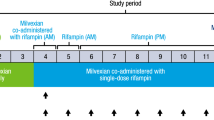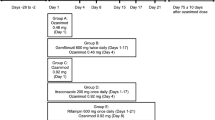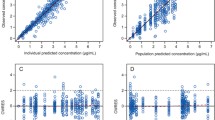Abstract
Objective: To determine the potential influence of prulifloxacin (AF3012, NM441), a new antibacterial fluoroquinolone, on the pharmacokinetics of theophylline.
Subjects and Methods: 12 healthy volunteers received a single oral dose of theophylline (6 mg/kg) in a control session and, thereafter, on the first and seventh days of an eight-day treatment regimen with oral prulifloxacin 600mg once daily. Plasma levels of theophylline were determined by a validated high performance liquid Chromatographic method in samples collected for up to 48 hours after each dose.
Results: Compared with the control session, prulifloxacin treatment was associated with a statistically significant increase in areas under the concentration-time curve (from a baseline value of 137 ± 9 mg/L·h to 157 ± 8, and 159 ± 9 mg/L·h on the first and 7th day, respectively; p < 0.01) and a prolongation in theophylline half-life (from 7.1 ± 0.3 hours at baseline to 8.1 ± 0.4, and 8.0 ± 0.4 hours on the first and 7th day, respectively; p < 0.01) with a consequent 15% decrease in theophylline apparent oral clearance (from 45.7 ± 2.8 ml/h/kg to 39.2 ± 2.0, and 39.0 ±2.1 ml/h/kg on the first and 7th day, respectively; p < 0.01). No differences were observed for peak plasma concentrations, time to peak concentrations and apparent volume of distribution.
Conclusion: These findings indicated that prulifloxacin decreases the elimination of theophylline, presumably by inhibiting cytochrome P450 1A2-mediated drug oxidation. Although this interaction is not expected to have important clinical implications, monitoring of possible changes in serum theophylline levels is recommended, as with all patients receiving theophylline in combination with agents potentially affecting drug metabolism.
Similar content being viewed by others
References
Segawa J, Kitano M, Kazuno K, et al. Studies on pyridonecarboxylic acids. 1. Synthesis and antibacterial evaluation of 7-substituted-6-halo-4-oxo-(1,3) thiazeto(3,2-a) quinoline-3-carboxylic acids. J Med Chem 1992; 35: 4727–38
Nakashima M, Uematsu T, Kosuge K, et al. Phannacokinetics and safety of NM441, a new quinolone, in healthy male volunteers. J Clin Pharmacol 1994; 34: 930–7
Ozaki M, Matsuda M, Tommi Y, et al. In. vitro antibacterial activity of a new quinolone, NM394. Antimicrob Agents Chemother 1991; 35: 2490–5
Ozaki M, Matsuda M, Tommi Y, et al. In vivo evaluation of NM441, a new thiazeto quinoline derivative. Antimicrob Agents Chemother 1991; 35: 2496–9
Yoshida T, Mitsuhashi S. Antibacterial activity of NM394, the active prodrug MN441, a new quinolone. Antimicrob Agents Chemother 1993; 37: 793–800
Kobayashi H, Kawai S, Sakayori S, et al. Dose finding study on NM441 in chronic respiratory tract infections. Jpn J Chemother 1996; 44Suppl. 1: 362–78
Kumazawa J, Matsumoto T, Kumamoto Y, et al. Clinical dose finding study on NM441 in complicated urinary tract infections. Jpn J Chemother 1996; 44Suppl. 1: 451–61
Fuhr U, Anders EM, Mahr G, et al. Inhibitory potency of quinolone antibacterial agents on cytochrome P450IA2 activity in vivo and in vitro. Antimicrob Agents Chemother 1992; 36: 942–8
Fuhr U, Strobl G, Manaut F, et al. Quinolone antibacterial agents — relationship between structure and in. vitro inhibition of the human cytochrome P450 isoform 1A2. Mol Pharmacol 1993; 43: 191–9
Wanogho E, Burke MD. Fluoroquinolone inhibition of cytochrome P450. Br J Clin Pharmacol 1993; 36: 168P
Edwards DJ, Bowles SK, Sensson CK, et al. Inhibition of drug metabolism by quinolone antibiotics. Clin Pharmacokinet 1988; 15: 194–204
Radandt JM, Randall MC, Dudley MN. Interaction of fluoroquinolones with other drugs: mechanisms, variability, clinical significance and management. Clin Infect Dis 1992; 14: 272–84
Upton RA. Pharmacokinetic interactions between theophylline and other medications. Clin Pharmacokinet 1991; 20 (Pt 1): 66–80
Wijnands WJA, Van Herwaarden CLA, Vree TB. Enoxacin raises plasma theophylline concentrations. Lancet 1984; II: 108–9
Nakabayashi M, Hashiguchi K, Miyashita N, et al. Effect of NM441 on serum concentration of theophylline. Jpn J Chemother 1996; 44Suppl. 1: 233–7
Niki Y Quinolone antimicrobial agents and theophylline. Chest 1992; 101: 881
Niki Y, Hashiguchi K, Kimura M, et al. Quinolone antibacterial agents and blood concentration of theophylline. Classification based on extent of drug interaction. Chemotherapy 1992; 40: 598–601
Sorgel F, Mahr G, Granneman GR, et al. Effect of 2-quinolone antibacterials, temafloxacin and enoxacin, on theophylline pharmacokinetics. Clin Pharmacokinet 1992; 22Suppl. 1: 65–74
Author information
Authors and Affiliations
Rights and permissions
About this article
Cite this article
Fattore, C., Cipolla, G., Gatti, G. et al. Pharmacokinetic Interactions between Theophylline and Prulifloxacin in Healthy Volunteers. Clin. Drug Investig. 16, 387–392 (1998). https://doi.org/10.2165/00044011-199816050-00006
Published:
Issue Date:
DOI: https://doi.org/10.2165/00044011-199816050-00006




